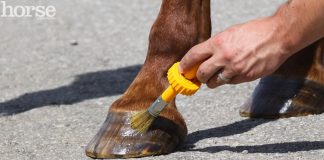Q: What causes “Stocking Up” and how
do I treat it?
referring to generalized swelling in a horse’s distal limbs. Medically this condition is known as a type
of localized edema, or accumulation of fluid in the subcutaneous tissues. Stocking up is most often seen in horses that
are stalled for a majority of the time, although some horses seem more prone to
stocking up than others within the same barn management system.
The
biology behind this form of edema is based in fluid dynamics. When a horse is standing still for long
periods, his circulation slows and becomes less efficient. When blood is moved more sluggishly through
the circulatory system, blood constituents such as plasma proteins have a
chance to leak out of the blood vessels (think of it as these proteins being so
bored with a sluggish circulation that they go in search of adventure elsewhere
out of the circulatory system). These
proteins have a strong “colloid pressure” which is a fancy fluid dynamic term
meaning fluid is drawn to where these proteins are located. In effect, these proteins pull fluid out of
the blood vessels and into the surrounding tissues, causing these tissues to
swell (become edematous), and therefore appear “stocked up”. The reason this edema is most prevalent in
the horse’s legs, usually below the hock and knee, is simply due to gravity.
Since
excessive stall time and resultant sluggish circulation are the primary causes
of stocking up, the most effective way to combat this condition is to increase
a horse’s time outside the stall, be it by pasture-boarding the horse and/or
simply riding more frequently. A horse’s
natural nomadic movements during grazing are enough to prevent stocking up in
pastured animals, but many horses do not have the luxury of wide-open fields
24/7. In cases such as these, daily
workouts are the best way to help combat stocking up in the stall-bound
horse. Keep in mind that the frequency
of exercise is the key to decreasing stocking up and not the length. Indeed, stalling a hot horse after a two-hour
ride may actually increase his chances of stocking up the next day. Ideally, a fifteen-minute hand walk in the
morning and a ride or lunging session in the evening should be enough to ward
off lower limb edema.
Actually,
stocking up in horses is exactly what also happens to some humans after a long
day on their feet – some people come home with swollen ankles while others
aren’t bothered at all. Likewise with
horses, some mounts become extremely stiff and reluctant to move after becoming
“stocky” while others don’t seem to mind much.
If you have a horse that is particularly sensitive to swollen legs, TLC
and empathy are the best aides, along with a slow, gentle hand walk for ten to
fifteen minutes. As the horse moves, the
fluid will slowly dissipate and the resultant pressure on the legs will
recede.
Standing
leg wraps are often used to combat stocking up in horses. While these wraps can and do help, it is
important to remember they are only treating the symptom and not the problem as
a whole. These wraps act to prevent
swelling by maintaining even pressure throughout the entire lower limb. Two key words for standing wraps are:
maintaining and even. The application of
standing wraps seems more of an art form than a science as these wraps require
a delicate balance of being tight enough to stay on and apply adequate pressure
to prevent fluid accumulation, while not being too tight to restrict blood
flow. Cold water hosing can also be
beneficial in some cases, especially if there is some heat noticed in your
horse’s legs.
Sometimes horse owners are tempted to give their mount a tablet of
phenylbutazone (bute) to help combat a particularly bad case of stocking
up. Like standing wraps, this is merely
helping the symptom and not tackling the problem as a whole. A bute once in a while is OK to help with
your horse’s aches and pains (ask your vet for proper dosage!) but is not a
panacea by any means. If your horse
chronically stocks up, it’s time to re-evaluate his stall management.
— Anna O’Brien
Ask your questions on the horseillustrated.com Forums >>
See more Expert Q&As >>
Submit your Ask the Expert question >>






I FEEL SO SORRY FOR STALL BOUND HORSES, AKA SHOW AND BOARDING HORSES. NO WONDER THEY DEVELOP BAD HABITS AND SWOLLEN LIMBS, THEY WANT/NEED OUT!!! A HORSE’S OVERALL BODY AND MIND HEALTH IS MUCH MUCH BETTER IF THEY ARE OUT OF A STALL AND CAN MOVE AROUND. I KNOW I WOULDNT LIKE BEING LOCKED IN A SMALL SQUARE ALL DAY AND NIGHT, AND ONLY BE ALOUD OUT TO GET A SHORT WORKOUT, A BATH, SOME TIME IN A SHOW, AND MY ROOM CLEANED!
I have never had this problem. Good information to know.
I’m glad my horses are out and about.
good artical
I appreciate this information. My horse is a pasture horse and stocks up when stalled/highlined overnight after long trail rides.
Thank you for this very informative article. My horse is stocking up even though she is not stalled at all, only in pasture.